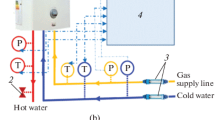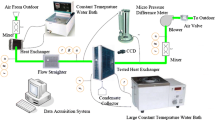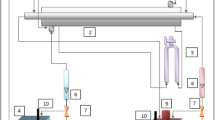Abstract
An experimental study of the effects of various factors (fin pitch, fin arrangement, air temperature, air humidity, and air velocity) on the frost growth and thermal performance of a fin-tube heat exchanger has been conducted under the frosting condition. It is found that the thermal performance of a heat exchanger is closely related to the blockage ratio of the air flow passages due to the frost growth. The maximum allowable blockage ratio is used to determine the criteria for the optimal operating conditions of a fin-tube heat exchanger. It is also shown that heat transfer rate of heat exchanger with staggered fin arrangement increases about 17% and the time required for heat transfer rate to reach a maximum value becomes longer, compared with those of an inline fin-tube heat exchanger under the frosting condition. The energy transfer resistance between the air and coolant decreases with the increase of inlet air temperature and velocity and with decreasing inlet air humidity.
Similar content being viewed by others
Abbreviations
- A :
-
Heat transfer area, m2
- a :
-
Flow area, m2
- BR :
-
Blockage ratio, %
- C p :
-
Specific heat at constant pressure, kJ/kg°C
- D :
-
Diameter, m
- i :
-
Enthalpy, kJ/kg
- L H :
-
Latent heat, kJ/kg
- m :
-
Mass, kg
- m :
-
Mass flow rate, kg/s
- q :
-
Heat transfer rate, kW
- R :
-
Energy transfer resistance, °C/W
- S :
-
Spacing, mm
- T :
-
Temperature, °C
- t :
-
Time, s or hr
- V :
-
Volume, m3
- w :
-
Specific humidity, kg/kg′
- X :
-
Thickness, m or mm
- σ:
-
Density, kg/m3
- a :
-
Air
- av :
-
Average
- c :
-
Coolant
- F :
-
Fin
- f :
-
Forst
- i :
-
Inlet
- inl :
-
Inline fin arrangement
- l :
-
Latent
- max :
-
Maximum
- o :
-
Outlet, outer
- s :
-
Sensible
- stg :
-
Staggered fin arrangement
- T :
-
Total
- t :
-
Tube
References
Aoki, K., Hattori, M., and Itoh, T., 1985, “A Study of Extended Surface Heat Exchanger with Frosting,” 1st Report, Overall Heat Transfer Characteristics,JSME Transactions, Ser. B., Vol. 51, No. 469, pp. 3048–3054.
Barrow, H., 1985, “A Note on the Frosting of Heat Pump Evaporator Surfaces,”J. Heat Recovery Systems, Vol. 5, No. 3, pp. 195–201.
Gatchilov, T. S. and Ivanova, V. S., 1979. “Characteristics of Extended Surface Air Coolers during Operation under Frosting Conditions”,Int. J. Refrig., Vol. 2, No. 4, pp. 233–236.
Gates, R. R. and Sepsy, C. F., 1967, “Heat Transfer and Pressure Loss in Extended Surface Heat Exchangers Operating Under Frosting Conditions-Part 1: Literature Survey,” Test Apparatus and Preliminary Results,ASHRAE Transactions, Vol. 73, Part 2, I. 2. 1-1. 2. 13.
Hayashi, Y., Aoki, K., and Yuhara, H., 1977, “Study of Frost Formation Based on a Theoretical Model of the Frost Layer,”Heat Transfer Japanese Research, Vol. 6, No. 3, pp. 79–94.
Hosoda, T. and Uzuhashi, H., 1967, “Effects of Frost on the Heat Transfer Coefficient,”J. Hitachi Review, Vol. 16, No. 6, pp. 254–259.
Kondepudi, S. N., 1988, “The Effects of Frost Growth on Fin Tube Heat Exchangers Under Laminar Flow,” Ph. D. Thesis. Texas A&M University.
Niederer, D. H., 1976, “Frosting and Defrosting Effects on Coil Heat Transfer,”ASHRAE Transactions, Vol. 82, No. 1, pp. 467–473.
Rite, R. W. and Crawford, R. R., 1991, “The Effect of Frost Accumulation on the Performance of Domestic Refrigerator-Freezer Finned-tube Evaporator Coils,”ASHRAE Transactions, Vol. 97, Part. 2, pp. 428–437.
Stoecker, W. F., 1957, “How Frost Formation on Coils Affects Refrigeration Systems,”J. Refrigeration Engineering, Vol. 65, No. 2, pp. 42–46.
Author information
Authors and Affiliations
Rights and permissions
About this article
Cite this article
Lee, KS., Kim, WS. The effects of design and operating factors on the frost growth and thermal performance of a flat plate fin-tube heat exchanger under the frosting condition. KSME International Journal 13, 973–981 (1999). https://doi.org/10.1007/BF03184764
Received:
Issue Date:
DOI: https://doi.org/10.1007/BF03184764




